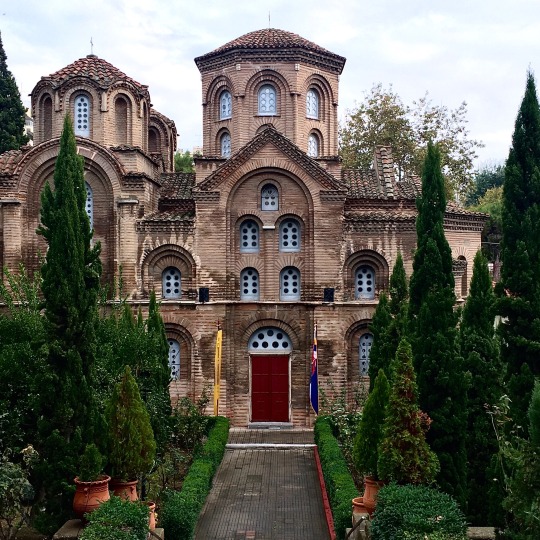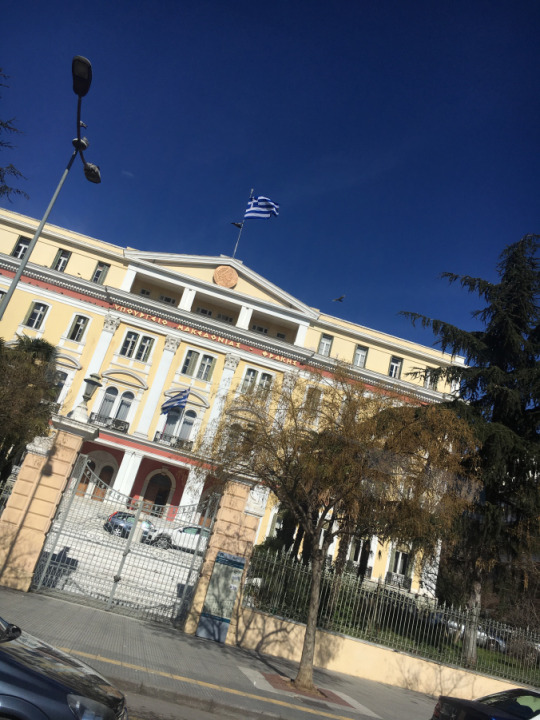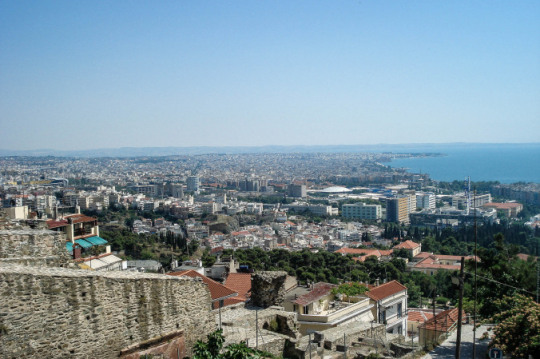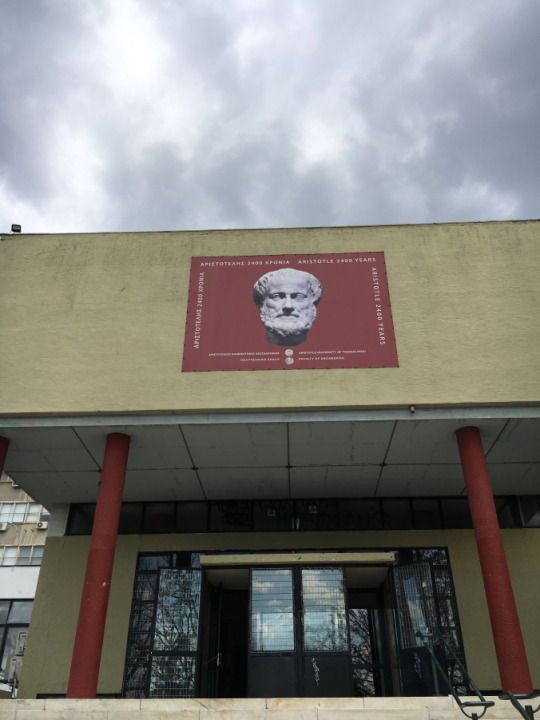#Panagia Chalkeon
Explore tagged Tumblr posts
Text
Athener Kaffee-Tagebuch: Thessaloniki bei Nacht II
An der Platia Aristotélous fand ich nächtens auch diesen Insta-Hotspot. Tagsüber hatte ich ihn geflissentlich übersehen, aber jetzt war er mir ein Foto wert. Am Obst- und Fruchtmarkt begannen die ersten Händler schon ihre Stände und Läden einzuräumen. Wie so oft ist auch hier der Erfolg von frühem Aufstehen abhängig. Im Vorbeigehen dieses erleuchtete Gebäude. Ich habe später nicht herausfinden…

View On WordPress
#visitthessaloniki#Insta#Instagram#Panagia Chalkeon#Platia Aristotélous#Platia Aristotelous#Thessaloniki#Thessaloniki bei Nacht#Unesco#UNESCO Welt-Kulturerbe#Unesco Weltkulturerbe
0 notes
Text

Panagia Chalkeon, XI th century Byzantine church, Thessaloniki
#photography#church#medieval#byzantine#greece#balkan#thessaloniki#architecture#byzantine art#byzantine architecture#orthodox christianity#europe#pic for sale
2 notes
·
View notes
Text
Zeus Hostel over the view of the Thermaikos Gulf
Zeus Hostel over the view of the Thermaikos Gulf
Zeus is Loose by Urban Soul Project – The design object of Zeus Hostel of Thermaikos Gulf, (on Olympus, Athens, Greece) is the result of three parameters: (a) the management of an existing office building of the 70’s on Aristotelous Square, in front of the historical monument of Panagia Chalkeon, (b) the typical facilities of a youth hostel, and (c) the concept of the place, the references to the…

View On WordPress
3 notes
·
View notes
Text

Παναγία Χαλκέων: Θρύλος 850 ετών! Κόκκινη εκκλησία ή Παναγία Χαλκέων. Αν και ο βυζαντινός ναός δεσπόζει στο κέντρο της Θεσσαλονίκης, στη δυτική πλευρά της αρχαίας αγοράς της πόλης, λίγ... Περισσότερα εδώ: https://elromio.gr/panagia-chalkeon-thrylos-850-eton/
0 notes
Photo






Monument of the Incantadas
Thessaloniki, Greece
2rd-3rd century CE
~13 m. in height
The monument called the “Enchanted Ones” or the “Idols”, Las Incantadas in Judeo-Spanish (Ladino), probably belonged to an important public building in the center of Roman Thessaloniki. It dates to the late 2nd or early 3rd century CE, and was positioned somewhere between the church of Panagia Chalkeon, The Paradise Baths, and Agios Nikolaos, along modern-day Aristotelous Street. In the 17th and 18th century the monument, known from travelers and painters of the era, was an impressive sight for the city’s residents and visitors.
Its façade, which was about 13 meters in height, was a two-story colonnade with Corinthian columns on the lower level and pillars on the upper one. The four pillars were decorated on their two main faces by eight reliefs of mythological figures. A Maenad, Dionysus, Ariadne, and Leda and the Swan-Zeus were depicted on the inner sides, while Nike, Aura, one of the Dioskouri, and the abduction of Ganymede were depicted on the outer ones. Until the 19th century, the monument survived in the heart of the Jewish quarter of Rogos, incorporated into the courtyard of a merchant.
As noted in travelers’ texts, this merchant broke off small pieces of the monument and sold them to tourists. In 1864 the French paleographer Emmanuel Miller, with a permit from the Ottoman government and in spite of the general reaction by the city’s population, dismantled the monument, brutally cutting it into pieces and transporting the sculptures to France, where they are today on display at the Louvre.
#art#Architecture#travel#history#monument#pillar#corinthian#statue#sculpture#thessaloniki#greece#asia#mediterranean#greek#Greek architecture#roman#roman architecture#arch#2 ce#3 ce#caryatid
386 notes
·
View notes
Text
Hello everyone!
Whether you’re on a tour around Greece or just chilling by the sea, Thessaloniki should definitely make it to your to-see list, because it’s not only about the famous tower and lovely promenade, the city offers much much more. I spent a week there recently with the Erasmus+ programme (student exchange) and during that week I really managed to see most of the city, and what we didn’t make during the day, I saw while walking the dog. So hence here it is, my guide to Thessaloniki!
The White Tower is the monument-symbol of Thessaloniki. Dating back to 1535, this 30 metres high tower is the sole survivor of 24 towers which were all part of the city’s fortifications once. Today it houses a museum exhibition about history of Thessaloniki.

Moving on further, the Archaeological Museum of Thessaloniki houses archaeological treasures from the dawn of prehistory up to late antiquity. You can also find there collections of ceramics, wall paintings and mosaics, as well as stone objects, metalwork and handicrafts.
Opposite this museum is situated OTE (Hellenic Telecommunications Organisation) and the Macedonian Museum of Contemporary Art with a large collection of painings, engravings, sculptures and photography.
Another interesting thing on the way further to the city centre is the Ippodromiou Square with archaeological findings from the Roman Hippodrome. Next to it is the liveliest square in the city, Navarinou Square, with the Palace of the Emperor Galerius, built in the early 4th century. Worth of mentioning is also the Church of Agia Sofia, one of the oldest and most important monuments of the Christian Orthodox faith, built in the early 7th century on the site of an older temple.
Aristotelous Square, with its view over the gulf, is the heart of Thessaloniki and the most important square in the city. It’s also the commercial centre, with the traditional Ladadika Quarter and very busy Modiano Market. On the north of the square you will find the 11th century Church of Panagia Chalkeon and the 15th century Bey Hamam baths. There you’ll also find the Hamza Bey mosque (also known as Alkazar) and directly opposite the Bezesteni Covered Market, which, according to travellers in the 16th century, was the most beautiful market in the Balkans.
Continuing further away from the sea, you’ll come up to the Diikitirio Square, where among Roman, Byzantine and Ottoman findings you’ll also find Government House – an architectonically interesting building built back in 1891, which formerly housed Ottoman services and nowadays houses the Ministry of Macedonia.

The Church of Agios Dimitrios, patron saint and protector of Thessaloniki, is one of the grandest Christian churches still standing. It is located rigth above the aforementioned spots, it’ll definitely catch your eye. This five-aisled basilica, which has 7th century frescoes and mosaics dating from 5th to 9th century, has been declared a UNESCO World Heritage Monument. To the right, heading towards the seam you will find ancient Agora. This was the social, religious and commercial centre of the city during Roman times. Heading from Agios Dimitrios via Agios Nikolaos and Kassandrou streets, you will see the Yeni Hamam and Alatza Imaret, distinctive examples of Ottoman architecture.
There are few things on the way to the Upper Town I want to mention. First of all, the era changes dramatically. Besides the monuments, you will see many parts of the traditional city grid, with narrow cobblestone streets and buildings with unique elegance and traditional Macedonian adornment. This area is also home to 13th century Byzantine Baths, as well as Church of Blessed David, the catholicon of Latomou Monastery and the oldest architectural example of its kind preserved in Europe.
The Church of the Taxiarches was first constructed in the 14th century but was converted into a mosque during Ottoman rule. The church is in Old Town, which was built on higher ground than the modern city and is still partly enclosed by the old citadel walls. With numerous Byzantine churches and monasteries, the Old Town exudes the atmosphere of an earlier era.
From Eptapyrgiou Street you can see the Byzantine fortification walls constructed by Theodosios the Great in 4th century, and one of the most important sights in the city. The walls end with Trigonio Tower, where you can enjoy an amazing view. Passing through the 2nd Portara (huge gate), you will come across Moni Vladaton, a monastery dating back to the 14th century and sole survivor among dozens of Byzantine monasteries that formerly existed in Thessaloniki. The forecourt offers a magnificent view of the city and over the gulf.

According to the lenged, Pasha Gardens right underneath are the site where St. Paul the Apostle taught when he visited Thessaloniki, and therefore the church lying in this area carries his name. The route here is downhill and runs parallel to the impressive Eastern Walls of the Old Town. These 4th century walls formerly extended all the way to the seafront.

On the way back to the seafront (still straight downhill), you will eventually get to the huge University Campus and its oldest building, the old School of Philosophy. The Aristotle University of Thessaloniki was founded in interwar period, and is the leading intellectual insitution in the city. On the right you will see the Church of Rotonda, a cyllindrical building dating back to the early 4th century AD, during the time of the Roman emperor Galerius. South of Rotona you can see the triumphal Arch of Galerius dating back from the same period.

When you get back to the White Tower, I recommend you to take a little walk along the coastline to see the Statue of Alexander the Great and Zongolopoulos Umbrellas, both located nearby. If you decided to take a walk to the left, you’ll find yourself on a long promenade and eventually you’ll get to the city’s second biggest municipality Kalamaria, and if you walk to the right, you will get to the main port and Cinema Museum.
Don’t forget to keep your eyes open to see all the magnificent perks of the local architecture and as always,
have a great day!
Thessaloniki guide
Hello everyone! Whether you’re on a tour around Greece or just chilling by the sea, Thessaloniki should definitely make it to your to-see list, because it’s not only about the famous tower and lovely promenade, the city offers much much more.
Thessaloniki guide Hello everyone! Whether you're on a tour around Greece or just chilling by the sea, Thessaloniki should definitely make it to your to-see list, because it's not only about the famous tower and lovely promenade, the city offers much much more.
0 notes
Photo

#behindthechurch #meetme #nightlights (at Church of Panagia Chalkeon)
0 notes
Photo

#greece 🇬🇷 #thessaloniki #skg #instatravel #theplace #theplacetobe #tb (hier: Church of Panagia Chalkeon)
0 notes
Photo

Thessaloniki's 11th century Panagia Chalkeon through its lush sub-tropical rose garden. During Ottoman rule (1430-1912) it was the mosque for copper workers & still held that dedication after restoration as an Orthodox church. @visit_thessaloniki @visitgreecegr @greekorthodox #greekmacedonia #culturaltravel #traveltuesday #ifwtwa http://ift.tt/2nA3SIa
0 notes
Photo

#greece 🇬🇷 #thessaloniki #skg #instatravel #theplace #theplacetobe (hier: Church of Panagia Chalkeon)
0 notes